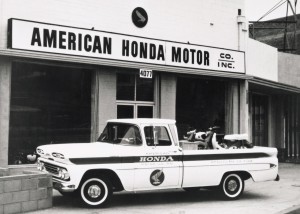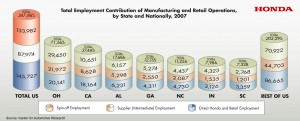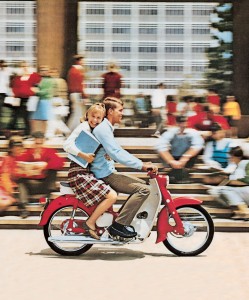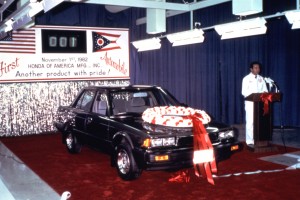A little over 50 years ago a handful of Honda associates led by 39-year-old Kihachiro Kawashima began signing up U.S. motorcycle dealers, working out of a small storefront office in Los Angeles, California.
The Honda Super Cub (50), Dream and Benly motor scooters were the initial Honda products sold in the U.S. First-year sales amounted to about 1,700 units.
American Honda‘s Japanese parent company was only itself 11 years old when it decided to start the first overseas subsidiary, in keeping with the philosophy of Japan’s Ministry of Trade and Industry’s export-driven industrial policy.
From this meager start, and because of a series of bold decisions that surprised much more conservative auto companies, such as Toyota and Nissan, Honda has grown to be a global giant, largely because of its steady expansion in the large, open and profitable U.S. market.
Today, American Honda employs more than 27,000 associates who are active in the design, development, manufacturing, sale and servicing of Honda and Acura products. The offerings now include automobiles, motorcycles, ATVs, personal watercraft, power equipment, and a light jet aircraft that is under development.
Honda now operates 10 U.S. manufacturing plants, with two new plants under construction, along with 14 research & development facilities and more than 12 regional sales, parts and service, and finance offices around the country.
The company’s network of U.S. parts suppliers has 545 companies in 34 states, with annual purchases exceeding $17.5 billion in 2008.
Like all other automakers operating in the ongoing Global Great Recession, Honda is currently struggling. The parent company lost almost $2 billion in the last quarter, and is under extreme pressure to stay profitable going forward, although, thus far, it is doing a better job of this than rivals Nissan and Toyota, which have been posting far deeper losses for longer periods of time.
American Honda sales through June of this year of 530,778 represent a 33% decrease. The Acura Division, at fewer than 18,000 vehicles, is off 26%. As a result, cutbacks are occurring across the board.
Significantly, Honda is also decreasing spending on new models, an ominous trend for a company known for its research and development and the new products that arise from it.
The innovation list, impressive enough by itself, also consistently foreshadowed larger social trends that changed the transportation business. Consider that Honda was the:
- First automaker to meet U.S. Clean Air Act without a catalytic converter — Civic CVCC (1974)
- First vehicle to top U.S. EPA list of most fuel efficient cars — Civic (1977)
- First Japanese automaker to assemble motorcycles (1979) and automobiles (1982) in America at Marysville, Ohio.
- First Japanese automaker to establish a luxury automobile brand — Acura (1986)
- First mass produced gas electric hybrid car introduced in America — Insight (1999)
- First government-certified hydrogen fuel cell vehicle — FCX (2002)
Now the question is can the company keep innovating?
It has not always been a smooth road for American Honda
Its first cars, starting with the tiny N600 (MSRP $1,275) was more a motorcycle with a hatchback body, and not suited for expansive, high-speed American roads. Early Civic and Accord models had severe quality problems, notably metal rusting rates that equaled that of sugar dissolving in water, which ultimately led to the recall of every vehicle ever sold in the U.S.

In 1959 American Honda started in the U.S. by selling motorcycles out of a small storefront in Los Angeles, California.
Though the actual volumes in the 1970s were small, the loss of face was huge, and it resulted in an attention to quality and detail that now has Honda ranking among the best in the world.
It was really the first energy crisis in 1975, however, that vaulted Honda into the automotive big time. The company had just introduced the Civic hatchback at $2,150, with a fuel-efficient, 4-cylinder engine and a front-wheel drive/front-engine layout. In 1975 the Civic CVCC (Compound Vortex-Combustion Controlled) became the first car to meet the new U.S. Clean Air Act exhaust emissions standards without the use of a catalytic converter. In 1977, the Civic CVCC led the Environmental Protection Agency’s first-ever list of the most fuel-efficient cars, posting an EPA fuel economy rating of 40 mpg. Later Honda became the first company to achieve a 50 mpg EPA rating.
During this period, the larger Accord, first as a hatchback, followed by a 4-door sedan competed with Toyota Camry and Nissan Maxima models as leading economy sedans. Detroit’s “Big Three”offerings could not compete with these little jewels in terms of design, quality, efficiency or customer satisfaction, a problem that haunts what remains of them to this day.
By the end of the decade, Honda was starting up production of motorcycles in America. The CR250M Elsinore from the Marysville Motorcycle Plant in Marysville, Ohio, made Honda the first Japanese maker to produce products of any kind in America.
Then on November 1, 1980, a slate-gray Accord Sedan came off the end of the assembly line at the Marysville Auto Plant (MAP), making Honda the first Japanese automaker to build automobiles in the U.S. During the next 25 years, Honda invested more than $3.8 billion in expanding and modernizing MAP, which to this day is one of the industry’s most flexible and efficient production facilities.
Acura was launched in March 1986 as the first luxury brand from a Japanese automaker. Sales of the Acura Legend Sedan and Integra 3-door and 5-door sports sedans begin at 60 Acura dealers in 18 states. Acura went on to become the best-selling import nameplate for 1987, and also led J.D. Power and Associates’ annual Customer Satisfaction Index (CSI) survey for four consecutive years (1987-1990).
Here, Toyota finally started to respond. In 1984 it cautiously entered U.S. manufacturing with a joint-venture with General Motors in California, a plant whose future today is uncertain. And in 1986, Toyota started assembling Corolla models in Kentucky.
Honda kept moving forward as well. The East Liberty Auto Plant (ELP) is opened in 1989. Honda’s second U.S. plant began production of Civic models in December. ELP is the first automobile plant in America to use more environmentally friendly waterborne paint.
The 1990s say Honda breaking ground in several areas. First the NSX sport car, arguably the most technologically advanced of the day, proved it could compete in the rarefied world of super cars that included more expensive Ferrari, Porsche and Corvette models, among others. The $65,000 NSX was the first production automobile with an all-aluminum chassis and body.
Honda also took on domestic makers with its innovative Odyssey minivan, whose size, quality and fold-away third-row seating caught them napping, and showed the way for even larger Honda and Acura entries, notably light trucks and SUV’s, all of which were succesful.
But the real reputational triumph came from the company’s pioneering work on emission control. Honda demonstrated that it was possible to meet the LEV, ULEV, and SULEV requirements with drivable vehicles, years ahead of the regulations, while other makers tried in the courts, unsuccessfully, to roll back the clean air movement.
The only real Honda set back in this era, and it was and is significant, came from Toyota’s Prius hybrid breakthrough and its numerous Toyota and Lexus derivatives, the global success of which still sees Honda struggling to emulate.
Nonetheless, sales of Honda and Acura vehicles exceed one-million units for the first time in a single year in 1998, as the Accord completed a decade as the best-selling vehicle to individual car buyers and the Civic was the best-selling compact car in America for the third consecutive year.
The 21st century saw the opening of Honda Manufacturing of Alabama in 2001, Honda’s third U.S. auto plant, building Odyssey minivans and V6 engines. In April 2004, a second assembly line was added, doubling its vehicle and engine production capacity to 300,000 units annually.
And just last year Honda Manufacturing of Indiana began production of 4-cylinder Civic sedans at Honda’s fourth U.S. auto plant in Greensburg, Indiana. The plant sets new standards for energy efficiency among Honda’s U.S. auto plants and is a zero-waste-to-landfill facility.
This year has Honda starting to redress the hybrid reputational gap.
Honda in Japan has just confirmed plans to begin sales of a CR-Z hybrid model in February 2010, with a hybrid version of the Fit model following before the end of the year.
Honda’s latest production hybrid, the Insight, is now selling well enough that the company is doubling changing the capacity at its Suzuka Japan, factory where it is made. In April, Insight was the best selling car in Japan, helped by government incentives. In May after its introduction, the Toyota Prius bumped it out of first place and held the lead in June.
Fit’s future outside of Japan is murkier, but it’s clear that Honda is once again moving forward with a technology based approach. Honda is now also developing a new hybrid system to be installed on mid- to large-size vehicles.
American Honda Motor Timeline
1959
- On June 11, American Honda Motor Co, Inc. is incorporated as the first overseas subsidiary of Honda Motor Co., Ltd., just eleven years after the company’s inception as a small Japanese motorcycle manufacturer.
- A handful of associates led by 39-year-old Kihachiro Kawashima begin signing up U.S. motorcycle dealers, working out of a small storefront office at 4077 Pico Boulevard in Los Angeles, California. The Honda 50 (Super Cub), Dream and Benly motorcycles are the first Honda products sold in the U.S. First-year sales amounted to just over 1,700 units.
1962
- Honda begins selling power equipment products in the U.S. Its first product is the F-190 tiller followed by the E-300 and E-40 portable generators in 1964.
- American Honda launches a 12-year ad campaign, “You meet the nicest people on a Honda” to create a new image of fun and friendly motorcycling with U.S. consumers. Advertisements appeared on billboards and in many of America’s most prestigious magazines of the day, and, in 1965, the company aired two 90-second commercials during the Academy Awards.
1963
- American Honda, now with approximately 800 motorcycle dealers around the country, moves its corporate headquarters from Pico Boulevard to new offices in Gardena, California.
- Honda not only has to establish itself in the U.S. motorcycle market, it has to overcome the negative stereotype of motorcyclists.
1968
- American Honda sells its one-millionth motorcycle in the U.S.
1969
- American Honda sells a handful of its first automobile, the diminutive N600 sedan, in Hawaii in 1969 followed by the start of sales in the continental U.S. in 1970. The N600 carries a manufacturer’s suggested retail price (MSRP) of $1,275
1973
- American Honda introduces the Civic hatchback at the outset of America’s first energy crisis. With an MSRP of $2,150, a fuel-efficient 4-cylinder engine, the Civic is a hit with car buyers.
- Honda introduces the industry’s first 4-stroke outboard marine engines, which are cleaner, quieter and more fuel-efficient than comparable 2-stroke motors.
1974
- The 1975 Civic CVCC (Compound Vortex-Combustion Controlled) is introduced as the first car to meet U.S. Clean Air Act exhaust emissions standards without the use of a catalytic converter. (In 1977, the Civic CVCC tops the U.S. EPA’s first-ever list of the most fuel-efficient cars in America with an EPA fuel economy rating of 40 mpg.)
1975
- Honda begins market research and new model development activities in the U.S. with the establishment of Honda Research California (later Honda R&D Americas, Inc.) in the company’s Gardena, California, headquarters.
- Honda introduces the GL1100 “Gold Wing,” which is competes with large cruising motorcycles from BMW and Harley-Davidson.
1976
- Honda Accord introduction, first as a hatchback, followed by the Accord 4-door sedan in 1979.
1977
- Honda announces U.S. assembly, starting with motorcycles, adding automobiles in the future. Honda of America Mfg., Inc. is formally established in February 1978.
1979
- On September 10, Honda of America Mfg. begins production of the Honda CR250M Elsinore motorcycle at the Marysville Motorcycle Plant in Marysville, Ohio, making Honda the first Japanese automaker to produce products of any kind in America. Honda decides to go ahead with plans for a new automobile factory in Ohio.
1980
- Honda breaks ground on a new $250 million auto plant in Marysville, Ohio.
1982
- On November 1, a slate gray Accord Sedan is driven off the end of the assembly line at the Marysville Auto Plant (MAP), making Honda the first Japanese automaker to build automobiles in the U.S. Over the next 25 years, Honda will invest more than $3.8 billion in expanding and modernizing MAP to ensure that it remains one of the U.S. auto industry’s most flexible and efficient production facilities.
1984
- In February, American Honda confirms its plans for a new luxury-performance division called internally “Channel II” as an alternative to well-established European brands. The new division is eventually named Acura.
- On August 6, Honda Power Equipment Mfg., Inc., begins assembling Honda lawnmowers at a new plant in Swepsonville, NC. The plant steadily expands its capacity to more than 340,000 lawnmowers and 2 million general-purpose engines annually.
- With heavy influence from American Honda and Honda R&D Americas, the company introduces the 1984 Honda CRX-HF, the first car to achieve an EPA fuel economy rating in excess of 50 miles per gallon.
1985
- On July 22, the Anna Engine Plant (AEP) in Anna, Ohio, begins production of Gold Wing engines. AEP would build its first automobile engine in September 1986 and goes on to become Honda’s highest volume engine plant in the world with an annual production capacity of 1.2 million units (in 2008).
- The Marysville Auto Plant (MAP) accomplishes the U.S. auto industry’s first rolling model change without a plant shutdown with the launch of the 1986 Accord. MAP is also the first U.S. auto plant to build left- and right-hand drive cars on one assembly line and the first to export cars to Japan, in 1988.
- Honda R&D Americas opens its Ohio Center for new vehicle development. The facility and its engineers go on to develop generations of the Honda Pilot and Acura MDX SUVs, Element, Ridgeline pickup, and the Acura TL sedan.
1986
- Acura is launched as the first luxury brand from a Japanese automaker. Acura goes on to become the best-selling import nameplate for 1987, and also tops J.D. Power and Associates’ annual Customer Satisfaction Index (CSI) survey for four consecutive years (1987-1990)
1988
- The Ohio-made Accord Coupe becomes the first U.S.-built vehicle ever exported to Japan with the start of exports on March 7. American Honda quickly becomes the #1 exporter of U.S.-built automobiles to Japan.
1989
- The East Liberty Auto Plant (ELP), Honda’s second U.S. auto plant, in East Liberty, Ohio, begins production of Civics in December. ELP is the first automobile plant in America to use more environmentally friendly waterborne paint.
- Honda company co-founder, Soichiro Honda, becomes the first leader of a Japanese automaker inducted into the U.S. Automotive Hall of Fame.
- The Accord becomes America’s top-selling automobile, a position it holds for three consecutive years (1989-1991).
1990
- The 1991 Acura NSX is launched as the first supercar from a Japanese automaker and the first production automobile with an all-aluminum chassis and body. The NSX, with an MSRP of $65,000, also debuts the company’s VTEC (Variable Valve Timing and Lift Electronic Control) engine technology for improved performance with reduced emissions and higher fuel efficiency, which is later applied to virtually all Honda and Acura vehicles sold in America.
- The 1991 Accord Wagon debuts as the first Honda vehicle to be designed, developed and manufactured in America.
1994
- American Honda introduces the first-generation Odyssey minivan based on an automobile unit-body platform. The Odyssey, with its fold-away third-row “magic seat” paves the way for Honda’s entry into the burgeoning U.S. light truck market.
- American Honda begins racing in the Indy Car World Series. Honda-powered cars go on to win 65 out of 164 races in several open-wheel series between 1994 and 2002, capturing six Driver’s Championships and four Manufacturer’s Championships.
1995
- 1995 Civic is the first automobile to meet California’s Low-Emissions Vehicle (LEV) exhaust emissions standards. Honda goes on to lead the industry in the introduction of low-emission vehicles including the first 50-state low-emissions car (1998 Civic), first ULEV (1998 Accord), first-to-market SULEV (2000 Accord), and first AT-PZEV (2001 Civic GX).
1996
- Honda Transmission Mfg. of America, Inc. begins production of gears and automatic transmissions for automobiles. The plant adds production of high-precision gears in 2006 and four-wheel-drive differentials in 2007.
1997
- American Honda begins leasing the Honda EV Plus battery electric vehicle (BEV), the first four-passenger BEV powered by advanced nickel-metal hydride batteries and an early example of Honda’s effort to advance electric drive technology.
1998
- Sales of Honda and Acura vehicles exceed one-million units for the first time in a single year as the Accord completes a decade as the best-selling vehicle to individual car buyers (excluding fleet sales) and the Civic is the best-selling compact car in America for the third consecutive year.
- Honda of South Carolina Mfg, Inc. opens a new 330,000-square-foot plant for the production of Honda Four Trax all-terrain vehicles (ATVs). The company would add a second plant for production of Honda AquaTrax personal watercraft in 2002.
- Sales begin of the natural gas-powered Honda Civic GX, powered by the cleanest internal combustion engine ever certified by the U.S. EPA.
1999
- The two-seat Honda Insight debuts in December as America’s first gasoline-electric hybrid vehicle. Featuring a lightweight, all-aluminum body and Honda’s “Integrated Motor Assist” hybrid technology.
2000
- Acura debuts the U.S.-designed and developed 2001 Acura MDX. With a fuel-efficient V6 engine, a lightweight all-wheel drive system and standard third-row seating.
2001
- Honda Manufacturing of Alabama, LLC, Honda’s third U.S. auto plant, begins production of Odyssey minivans and V6 engines. In April 2004, HMA would add a second assembly line and double its vehicle and engine production capacity to 300,000 units annually.
- Honda R&D Americas, Inc. opens the first solar-powered hydrogen production and fueling station built and operated by an automaker, at its U.S. headquarters facility in Torrance, California.
- The 2001 Honda Civic Coupe is the first compact car to earn a five-star rating from the National Highway Traffic Safety Administration (NHTSA) for both frontal and side impacts.
2002
- American Honda introduces the Civic Hybrid, the first application of hybrid technology to an existing, mass-produced automobile.
- The Honda FCX is the industry’s first fuel cell car to earn certification for regular commercial use from both the U.S. EPA and California Air Resources Board (CARB). The City of Los Angeles takes delivery of two FCX cars on December 2 as the world’s first commercial customer for a fuel cell vehicle.
2003
- Honda R&D opens a state-of-the-art new safety test facility in Ohio, equipped with the world’s highest resolution crash-test barrier and the world’s first pitching test sled to more accurately simulate the dynamics of a crash event.
- The HondaJet advanced light jet makes its inaugural test flight on December 3 at the Piedmont-Triad International Airport in Greensboro, NC.
- American Honda cumulative product sales, including automobiles, powersports and power equipment products, surpass the 50-million-unit mark, including more than 20-million automobiles.
2005
- The 2006 Honda Civic is the first compact car to earn a “Top Safety Pick” rating from the Insurance Institute for Highway Safety (IIHS).
- The Spallino family takes delivery of a Honda FCX, becoming the world’s first individual customer for a fuel cell car.
- Leasing begins of the “Phill” home refueling appliance to expand the appeal and convenience of its Civic GX natural gas-powered vehicle technology.
- Honda introduces Variable Cylinder Management, the industry’s first cylinder deactivation technology for V6 engines.
2006
- Honda R&D Americas, Inc. opens two new design studios in Southern California, including an Acura Design Studio in Torrance and the Advanced Design Studio for future products in Pasadena.
2007
- Honda is “Greenest Automaker” by the Union of Concerned Scientists for the fourth consecutive time in the organization’s biennial study of automakers’ U.S. automobile fleet smog-forming and greenhouse gas emissions.
- American Honda begins sales of its micro-combined heat and power (MCHP) co-generation technology in the Northeastern United States, offering the potential for a significant decrease in energy consumption and CO2 emissions associated with home heating.
- Honda introduces the world’s first production motorcycle with an available rider airbag system, on the 2008 Honda Gold Wing.
2008
- Honda Manufacturing of Indiana, LLC, begins production the 4-cylinder Civic Sedan at Honda’s fourth U.S. auto plant in Greensburg, Indiana. The plant sets new standards for energy efficiency among Honda’s U.S. auto plants and is a zero-waste-to-landfill facility.
- American Honda begins lease sales of its next-generation FCX Clarity fuel cell car to customers in Southern California.
2009
- The 2010 Honda Insight launches in March with an MSRP of $19,800, making it the least expensive hybrid car in America.

Honda was first Japanese automaker to assemble motor vehicles in the United States. Starting with a small motorcycle sales office in Los Angeles in 1959, Honda has grown into a multi-line operation throughout the country to include automobiles, power equipment, powersports, engines and jet aircraft. Click to enlarge chart.


